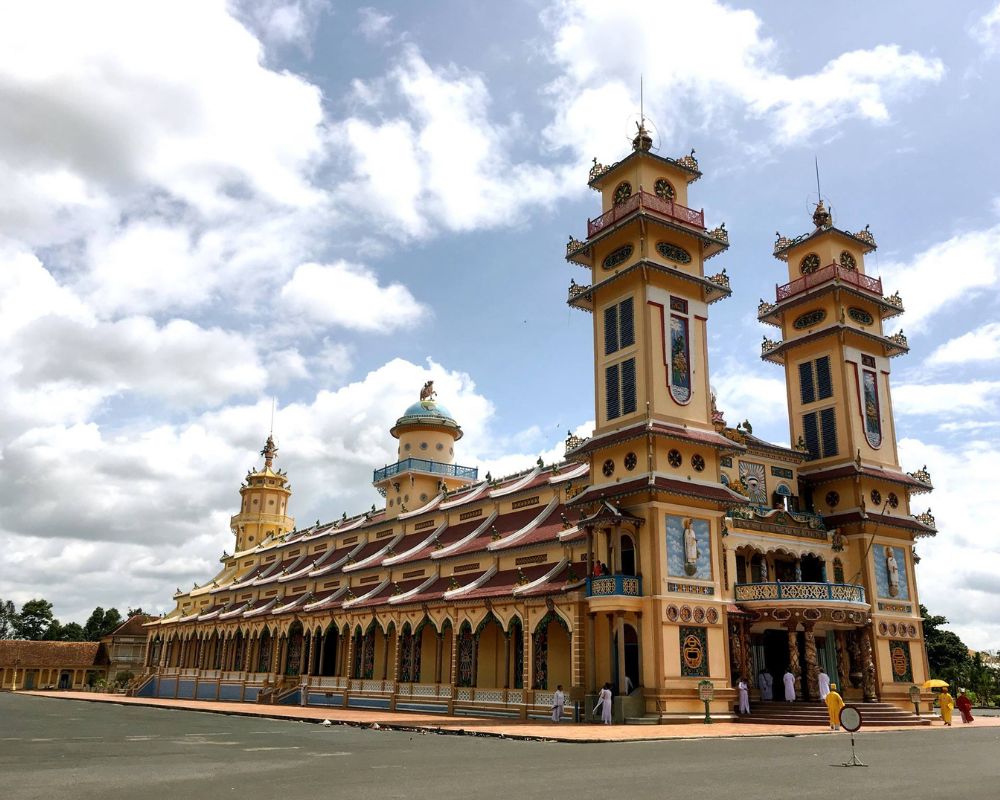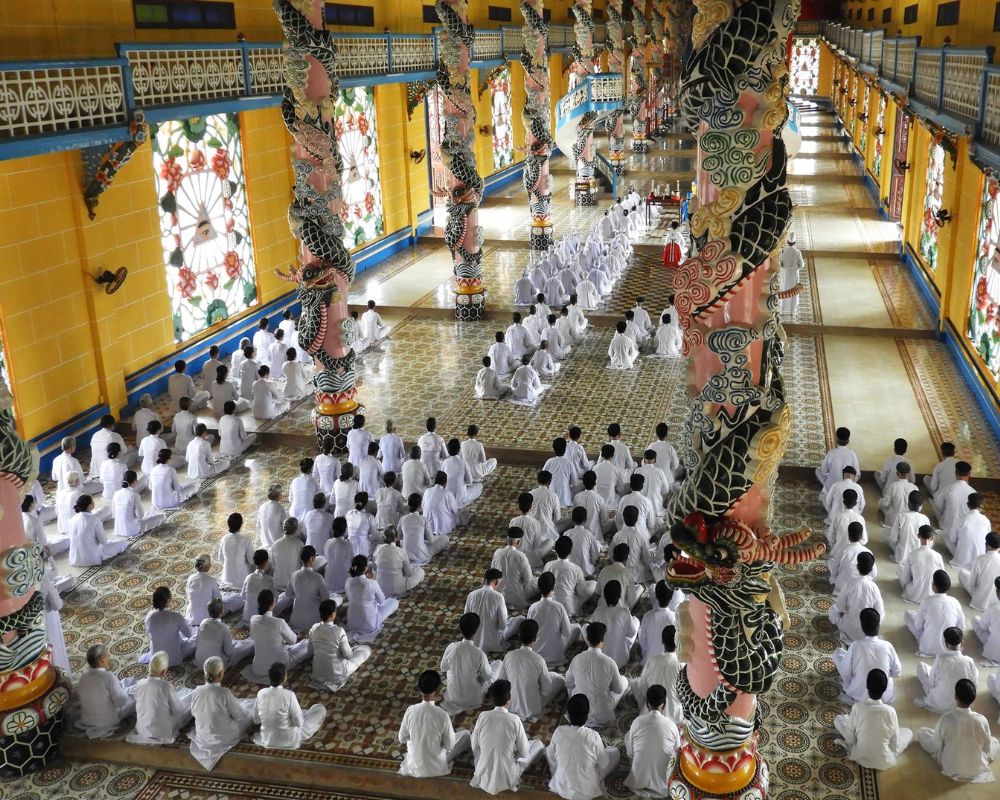If you come to Ho Chi Minh City and feel bored because of the experience of enjoying at the night streets, walking around, eating snacks with friends, and watching the city from the skyscrapers, choosing a sacred location will make you feel refreshed. Cao Dai Temple, with a combination of East-West harmonious architecture, will make you not disappointed.
Where is the Cao Dai Temple?
Cao Dai Temple, also known as the Great Temple or Tay Ninh Holy See, is located in Tay Ninh Province, in the southeast region of Vietnam, about 90 km from Ho Chi Minh City to Tay Ninh. This temple is the center of Caodaism, a unique religion that blends elements from Buddhism, Christianity, Taoism, Confucianism, and Islam.
The temple is renowned for its striking architecture, which reflects the eclectic nature of Caodaism, featuring bright colors, dragons, flowers, and a blend of symbols from various religions.
Cao Dai religion - Caodaism
Cao Đài, or Caodaism, is a unique and syncretic Vietnamese religious movement that officially emerged in Vietnam in the early 20th century. The religion combines elements from major world religions, including Buddhism, Taoism, Confucianism, Christianity, and Islam, alongside ideas from Vietnamese spiritual traditions.
The foundation of Caodaism is based on the belief in a single, supreme God and creator, often depicted as an eye in a triangle, symbolizing the divine presence overseeing humanity. The religion emphasizes the goal of universal harmony and unity among all religions and beliefs, promoting peace, tolerance, and understanding.
Caodaism was established in the 1920s in Tây Ninh Province, southern Vietnam, through a series of séances by a group of Vietnamese spiritualists who claimed to receive messages from the Divine.
These messages, which were believed to be from spirits of religious leaders and notable historical figures, guided the formation of Caodaism’s doctrines and practices. Ngô Văn Chiêu, a former colonial administrator, is credited as one of the key figures in founding the religion.
One of the most distinctive practices in Caodaism is the colorful and elaborate rituals performed by its adherents, including daily prayer sessions. Followers are easily recognized by their white robes, with higher-ranking clergy wearing robes of different colors representing the religion's three main branches: Buddhism (yellow), Taoism (blue), and Confucianism (red).
The temple's architecture reflects the eclectic and syncretic nature of the religion, incorporating symbols and elements from various religious traditions.
Caodaism also places a strong emphasis on vegetarianism, non-violence, and the practice of séances as a means of communicating with the spiritual realm. The religion's teachings advocate for personal cultivation and enlightenment, leading to a harmonious society.
Despite facing persecution and restrictions, particularly during the Vietnam War and under subsequent communist governments, Caodaism has endured and continues to be practiced by millions of followers, primarily in Vietnam but also among Vietnamese diaspora communities worldwide.
>>Read more: The History Of The Black Virgin Mountain Tay Ninh Vietnam
Architecture of Cao Dai Temple
The Cao Dai Temple, an example of architectural exuberance, is brightly painted in all colors of the rainbow and daily hosts hundreds of worshippers in their fluttering white robes. At the front of the Cao Dai temple is a large eye and two square pagoda-style.
Even the front of the main temple looks saggy, but that's just an optical illusion from the stairs leading up to it. Somehow, though, this pretentious building manages to rise above the tacky, despite the fluorescent colours and rococo excess.

Cao Dai Temple
Statues of Jesus Christ, Buddha, and the Hindu god Brahma stood at the entrance. Inside, the most common motif in the temple was an eye surrounded by a triangle—the same symbol seen on a US dollar.
Of specific interest may be the complex where the temple is located. There are several smaller sacred buildings there, and houses for the devotees, as well as a special hospital for homeopathic treatments.
As a tourist inside the Cao Dai Temple, one is allowed to walk down the aisles but not to move between the rows of pink Corinthian pillars that have green dragons crisscrossing.
>>Read more: One day exploring Lo Go Xa Mat National Park Tay Ninh
Ceremonies at the Cao Dai Temple
The ceremonies at the Cao Dai Temple in Tay Ninh, Vietnam, are vibrant and deeply spiritual events that reflect the unique syncretism of Caodaism.
These ceremonies are a visual feast, characterized by their rich symbolism, colorful attire, and solemn rituals that blend elements from various major world religions.
The most significant and visually striking ceremony occurs daily, with the noon prayer being the highlight for many visitors. During this ceremony, followers of Caodaism gather in the temple's grand hall, a vast and ornately decorated space illuminated by natural light from above.
The adherents are dressed in long robes of different colors, each signifying their spiritual affiliation within Caodaism: yellow for Buddhism, blue for Taoism, and red for Confucianism, with white being worn by lay worshippers.
As the ceremony begins, the worshippers arrange themselves in orderly rows according to their hierarchy in the religion, creating a stunning visual spectacle. The air fills with the sounds of traditional Vietnamese instruments and chanting, enhancing the spiritual ambiance of the ceremony.
At the front of the hall, near the altar, high-ranking officials lead the congregation in prayers and hymns. Central to Caodaist worship is the representation of the "Divine Eye," symbolizing God's presence, which is prominently displayed.
The ceremony involves a series of ritualistic offerings, readings from sacred texts, and collective prayers, aiming to promote peace, understanding, and unity both within the community and globally.
Visitors to the Cao Dai Temple are welcomed to observe these ceremonies, offering a rare glimpse into the practices of one of the world's most unique religions.
Observers are expected to dress modestly and behave respectfully, maintaining silence and avoiding any actions that could disrupt the solemnity of the occasion.
The ceremonies at the Cao Dai Temple not only serve as a form of worship but also as a vivid demonstration of Caodaism's core values of harmony and inclusivity, drawing from the teachings of multiple religions to create a unique and peaceful spiritual path.

Ceremonies at the Cao Dai Temple
>>Read more: Car Rental For Cu Chi Tunnel - Cao Dai Temple Tour Full Day
Combine with Cu Chi Tunnels tour
Most tourists tend to combine their visits with the Cu Chi Tunnels tour. The tours mostly start early in the morning from Ho Chi Minh City to be able to visit the tunnels, after which they usually have a scheduled visit to the temple for prayer at 12pm.
Few tourists make their way to the temple independently. If wanting to do this, it's best to agree a fixed price with a taxi driver or Grab driver. It is then nice to combine a visit to the temple with the Ba Den Mountain.
You can see more at Cu Chi Tunnels - Cao Dai Temple - Black Virgin Mountain Tour 1 Day
